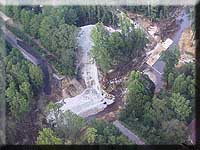
Story by Bob Loehne - "Photos by CSX", layout and graphics by Joey G.
|
|
While that is not the exact conversation observers on
the CSX helicopter transmitted to CSX's disaster recovery team, it likely
is close to reality for the spotters who spent a rare day watching the railroad
slowly submerge. The wrath of hurricane Floyd was phenomenally excessive
and even an industrial giant like CSX – at times a juggernaut in its
own right – could at best simply prepare, stay safe, take note of the
damage and then respond once the way was again safe.
|
 |
"Quankey Creek at Halifax" To see four other stages of Halifax flood damage and track repair click the links: "Hanging Track", "Begin Repairs", "Heavy Equipment" and "High Fill Ready" |
|
|
Contrary to popular rumor, CSX's Tar River bridges at Rocky Mount were not washed away. Once the flood waters rose over the tracks, aerial views showed only the thru truss bridge while the black deck girder bridge totally was submerged and perhaps presumed missing. |
|
|
By Monday, most flooded areas along the A Line were receding and the mainline itself reappeared. As access allowed, crews began initial track repairs and started the voluminous carriage of rip rap to the damaged right-of-way. Initial CSX projections called for the A Line to be back in service by Thursday, the 23rd, but the yeomen effort of planning, dumping and rebuilding actually allowed the A Line's first revenue train — southbound Q400 at Halifax — to run on Wednesday. |
|
|
Except for the Silver Star, which diverted over Norfolk
Southern's route through Lynchburg to Charlotte and then to Columbia and
Savannah, Amtrak canceled its entire Washington-Florida service. After a
day for CSX to work out the kinks, Amtrak resumed its full Florida Silver
service (three trains) on Thursday. Except for a few slow orders, CSX's A
Line was back up to speed the next morning. |
CSX officials had been watching Floyd and, as its path
was projected, began implementing the emergency evacuation plan. Twelve hours
prior to Floyd's predicted arrival, CSX discontinued Amtrak trains and four
hours later all freight operations were likewise shut down. Employees and
families were moved to safety and equipment was transported farther inland;
however, no one — railroad, state or TV weather forecasters — projected
Floyd's high and devastating flood waters. |
The cost of Floyd to CSX was temporary loss of or delayed
service, damaged bridges and rights of way, and tremendous amounts of rock.
There have been several quotes on total tons of rock, but with various
superintendents ordering and a variety of wags keeping count, the exact tonnage
is not known. However, if you look at the Halifax photo titled "High Fill
Ready" you'll get a sense of the rock fill required for just that one
washout. |
Use drop menu to access all areas of this issue